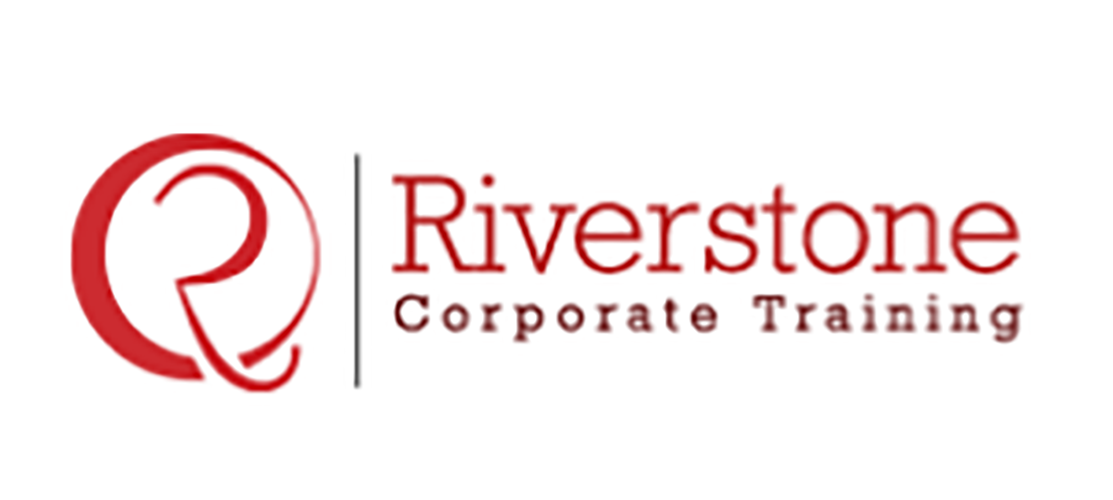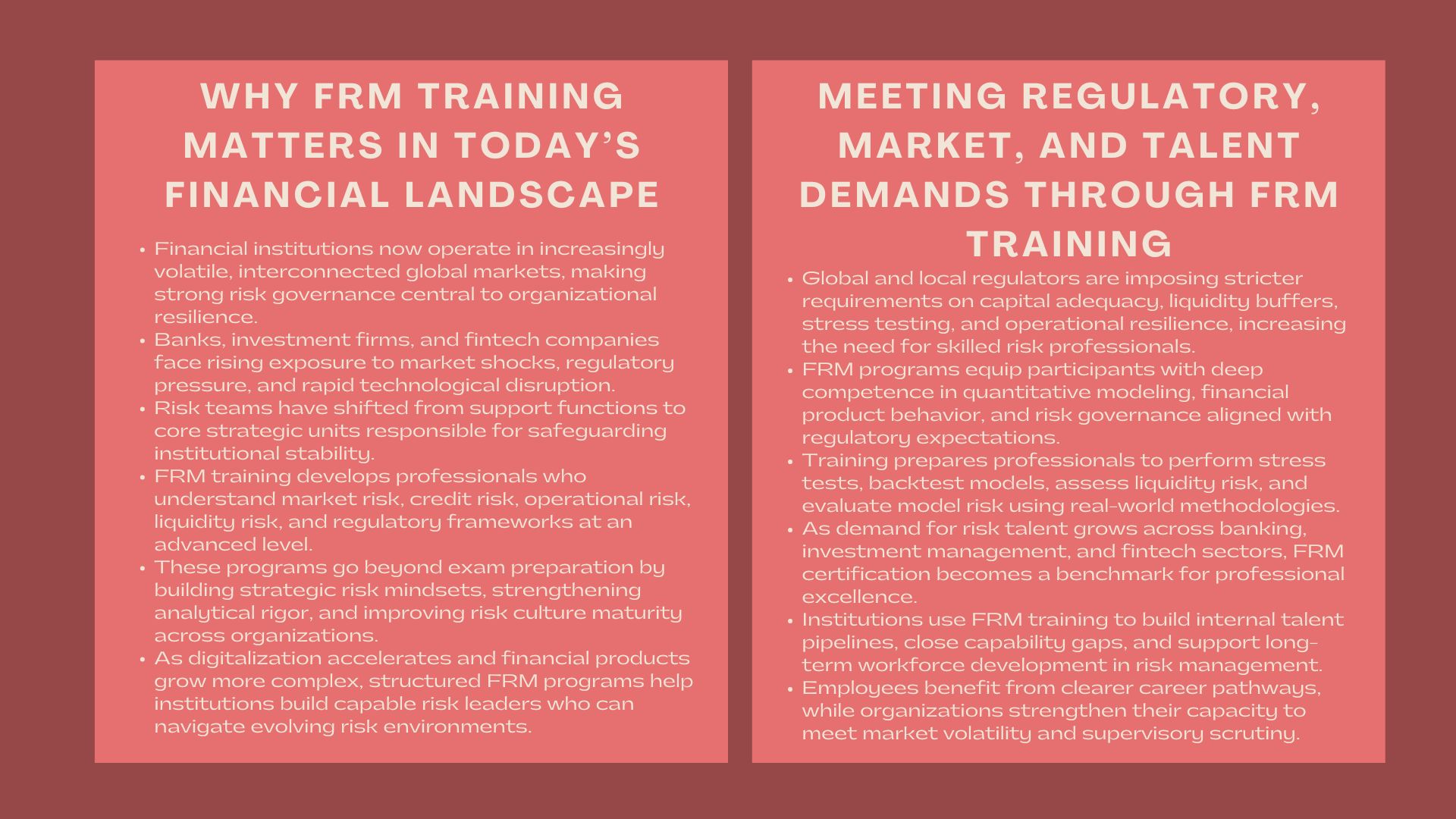FRM Training Programs for Banks, Investment Firms, and FinTech Companies
Introduction to Certified FRM Program for Finance Teams
In today’s increasingly complex financial landscape, institutions across banking, investment management, and financial technology face amplified exposure to global uncertainty. The speed at which financial markets evolve, combined with the deep interconnectedness of international capital flows, has heightened the importance of robust risk governance frameworks. Organizations must now contend with unpredictable market behavior, regulatory changes that demand rapid operational adjustment, and the pressures brought by technological disruptions. These emerging realities have reshaped the role of risk professionals and placed financial risk management at the center of institutional strategy. Risk teams are no longer peripheral support units but have become strategic pillars essential to corporate sustainability.
As firms seek to strengthen their resilience, the importance of developing technically proficient and forward-thinking risk professionals has never been greater. This need is further accentuated by rapid technological innovation, the introduction of artificial intelligence in financial modeling, increased digitalization of financial services, and the proliferation of complex financial instruments.
The Financial Risk Manager (FRM) qualification has emerged as one of the most respected and globally recognized designations in the risk profession. FRM-certified individuals possess deep knowledge in market risk, credit risk, operational risk, liquidity management, quantitative analysis, and regulatory frameworks governing financial institutions. As such, institutions across sectors increasingly recognize the value of investing in a financial risk manager (FRM) certification preparation course to develop internal talent pipelines capable of navigating sophisticated risk environments.
FRM training programs deliver far more than exam preparation. They help build a strategic risk mindset, enhance analytical discipline, promote regulatory fluency, and elevate the overall maturity of an institution’s risk culture. These programs support both individuals pursuing certification and organizations aiming to build collective risk competency. By integrating structured learning, case-based analysis, and cross-functional risk perspectives, FRM programs strengthen institutional resilience and ensure that financial professionals operate with advanced risk awareness. As financial ecosystems continue to evolve, structured FRM training stands as a cornerstone for developing high-impact risk leaders capable of sustaining competitiveness in a volatile global environment.
The Growing Need for Structured FRM Training
Enhancing Risk Capabilities to Support Regulatory and Market Demands
Financial institutions today operate under unprecedented regulatory scrutiny. Global and regional regulators continue to introduce rigorous standards revolving around capital adequacy, liquidity buffers, operational resilience frameworks, risk governance structures, and stress-testing requirements. These expectations demand that organizations maintain an advanced level of risk analytics, model integrity, data consistency, and control system robustness. As risk frameworks grow more complex, organizations need professionals who can interpret supervisory guidelines, implement regulatory expectations, and translate them into effective risk management practices.
Structured FRM training plays a transformative role in meeting these regulatory expectations. Participants develop deep competence in quantitative risk methodologies, financial product behavior, and risk governance. They also gain exposure to advanced modeling techniques and learn how to evaluate key risk metrics used by global regulators and central banks. An frm exam-focused risk management training for banking professionals ensures that risk teams understand how to perform stress tests, backtest risk models, assess liquidity risks, and evaluate model risk under real-world conditions. This training strengthens internal governance structures by ensuring that risk professionals can analyze exposures comprehensively and produce reporting that meets supervisory standards.
Moreover, in an environment where regulators expect risk teams to anticipate vulnerabilities rather than merely respond to them, FRM training enables professionals to think proactively. Participants learn to observe patterns in economic conditions, interpret shifts in market sentiment, identify early warning indicators, and evaluate the potential impact of macroeconomic transitions. This proactive mindset strengthens institutional resilience and supports leadership teams in crafting informed strategic decisions.
Building Talent Pipelines for the Expanding Risk Management Profession
As risk profiles evolve across industries, demand for skilled risk professionals has risen sharply. Banks need analysts capable of modeling credit exposures, managing liquidity risks, and evaluating capital adequacy under different economic scenarios. Investment firms require risk professionals who understand market volatility, portfolio risk sensitivities, performance attribution, and complex derivative structures. Fintech companies face emerging risks such as cybersecurity threats, data governance concerns, technology reliance, and algorithmic modeling vulnerabilities.
This environment has created a global talent shortage in the risk profession. Institutions increasingly recognize the need for structured talent development pipelines to build competent risk teams from within. FRM training plays a crucial role in this effort. Participants gain a strong foundation in financial theory, risk analytics, and regulatory frameworks that enable them to perform in high-stakes environments. They develop knowledge spanning derivatives pricing, exposure quantification, risk governance, operational risk control, and model validation.
The FRM designation also serves as a benchmark for professional excellence. Institutions that support employees in pursuing FRM certification gain a distinct advantage in attracting and retaining top-tier talent. Employees view FRM support as an investment in their career progression, while organizations benefit from cultivating trained professionals capable of contributing to risk strategy, regulatory compliance, and cross-functional governance. As risk management becomes more specialized, structured FRM programs ensure that institutions build long-term capability aligned with organizational objectives and industry demands.
Core Areas of FRM Training Program Development
Designing Curriculum That Reflects Real-World Risk Scenarios
A comprehensive FRM training program must mirror the complexity of real-world financial environments. Effective programs blend theoretical fundamentals with practical experience, ensuring that participants can apply risk concepts within institutional settings. The curriculum must address the full spectrum of risk domains tested in the FRM exam, including market risk, credit risk, operational risk, liquidity risk, and quantitative analysis. However, beyond exam content, training must incorporate real-world case studies that reflect contemporary financial challenges.
Participants engage with case simulations derived from economic downturns, market disruptions, credit default waves, regulatory interventions, and operational incidents. They learn how financial institutions respond to these crises and analyze the effectiveness of risk frameworks under extreme conditions. The curriculum exposes participants to tools used by global risk teams, such as Value at Risk (VaR), Expected Shortfall, Monte Carlo simulation, stress-testing methodologies, scenario analysis, backtesting techniques, and credit risk modeling.
By integrating both academic rigor and practical relevance, FRM programs prepare individuals to operate confidently in professional risk environments. Participants learn not only how to compute risk metrics but also how to interpret results, challenge assumptions, and understand the implications for balance sheets, portfolios, and governance systems. This bridging of theory and practice improves analytical accuracy, strengthens institutional risk oversight, and ensures participants are prepared for both the FRM exam and real-world responsibilities.
Developing Analytical Competence Through Quantitative and Conceptual Training
Risk management is a deeply analytical discipline that demands strong quantitative fluency. FRM training programs therefore place significant emphasis on developing participants’ abilities in statistical modeling, probability theory, time-series analysis, distribution behavior, and sensitivity analysis. Participants learn how to quantify risks associated with financial products, evaluate exposure under different market scenarios, and model the behavior of risk factors. They gain the ability to test hypotheses, validate assumptions, and evaluate the limitations of analytical models.
At the same time, conceptual depth is essential for interpreting risk results within institutional contexts. Participants build a solid understanding of market structures, macroeconomic dynamics, regulatory frameworks, behavioral finance theories, and governance principles. They explore how risk arises across financial products and operational processes. They examine the interplay between risk analytics, risk controls, internal procedures, and strategic planning.
The combination of quantitative and conceptual development ensures that participants do not view risk in isolation. They learn how to apply models responsibly, understand the broader implications of analytical outputs, and contribute to the strategic decisions that shape institutional resilience. Through this integrated learning approach, training programs produce well-rounded professionals capable of performing complex risk analysis and interpreting results within a holistic risk governance framework.
Implementation Across Banks, Investment Firms, and FinTech Companies
Adapting FRM Training to Organizational Structure and Sector Priorities
The nature of risk varies significantly across industries, and effective FRM training must reflect these sector-specific nuances. Banks manage loan portfolios, liquidity risk, funding structures, interest rate risk, and financial crime risk. Their training therefore requires emphasis on credit modeling, Basel requirements, stress testing, and interest rate risk in the banking book.
Investment firms operate in markets where volatility, portfolio allocation, derivative structures, and pricing models are central. Their version of FRM training focuses on market risk measurement, asset class behavior, portfolio construction, and risk-adjusted performance. Understanding market correlation structures, pricing anomalies, and hedging strategies becomes essential.
Fintech companies face emerging and rapidly evolving risks. They must manage technology risks, cyber threats, data privacy exposures, cloud dependencies, algorithmic model behaviors, fraud vulnerabilities, and operational disruptions. FRM training for fintech professionals incorporates technology-centric scenarios, model validation frameworks, and governance of automated decision-making systems.
By tailoring FRM training to these specific risk contexts, programs ensure relevance, effectiveness, and immediate applicability. Participants gain the tools needed to strengthen sector-specific risk processes, build stronger control environments, and support the institution’s strategic risk agenda.
Integrating Cross-Functional Skills to Strengthen Enterprise Risk Governance
Risk management today requires collaboration across multiple functions. Treasury teams monitor liquidity positions, financial planning teams model capital needs, compliance teams ensure regulatory adherence, audit teams evaluate control integrity, and technology units support model infrastructure. FRM training programs incorporate cross-functional learning to strengthen enterprise-wide coordination.
Participants learn how to communicate complex analysis in ways that support informed decision-making. They understand how to identify cross-functional dependencies and incorporate insights from multiple departments into risk assessments. This collaborative mindset helps institutions break down operational silos and ensures that risk awareness extends across all business functions.
By integrating cross-functional skills, FRM training promotes risk alignment throughout the organization. It strengthens governance structures and ensures that leadership receives holistic insights rather than isolated reports. As financial institutions face increasingly interconnected risks, the ability to synthesize perspectives across divisions becomes central to maintaining operational stability.
Strengthening Critical Thinking and Professional Judgment
Developing Strategic Risk Insight for Anticipating Market Challenges
Modern financial markets shift rapidly in response to geopolitical developments, macroeconomic cycles, technological disruptions, and regulatory reforms. FRM training strengthens participants’ ability to interpret these dynamics and anticipate potential risk implications. Participants learn how market shocks propagate, how systemic vulnerabilities emerge, and how risk indicators evolve during stress environments.
Through structured analysis, risk professionals develop foresight, enabling them to anticipate emerging threats and prepare strategic responses. This insight is vital for institutions operating in volatile environments where early detection of market instability can mitigate losses and enhance long-term resilience.
Enhancing Communication and Analytical Interpretation for Decision-Makers
Analytical insights hold value only when communicated effectively. FRM training programs develop participants’ ability to translate quantitative risk outputs into narratives that support decision-making. Professionals learn how to explain model behavior, disclose underlying assumptions, and communicate results with clarity.
Participants also strengthen their ability to present findings to executive committees, regulators, and cross-functional teams. Improved communication enhances organizational risk awareness, supports stronger governance decisions, and ensures that risk insights contribute directly to strategic and operational planning.
Conclusion
FRM training programs have become essential for banks, investment firms, and fintech companies seeking to strengthen their risk management capabilities in an increasingly complex financial environment. Through comprehensive technical training, real-world application, and sector-specific adaptation, FRM preparation programs equip professionals with the skills necessary to navigate modern financial risks. A rigorous financial risk manager (FRM) certification preparation course offers participants the analytical depth, regulatory understanding, and strategic awareness required to meet industry expectations. At the same time, an intensive frm exam-focused risk management training for banking professionals positions institutions to enhance governance, strengthen decision-making, and build the risk-ready workforce needed for long-term resilience and competitiveness.


